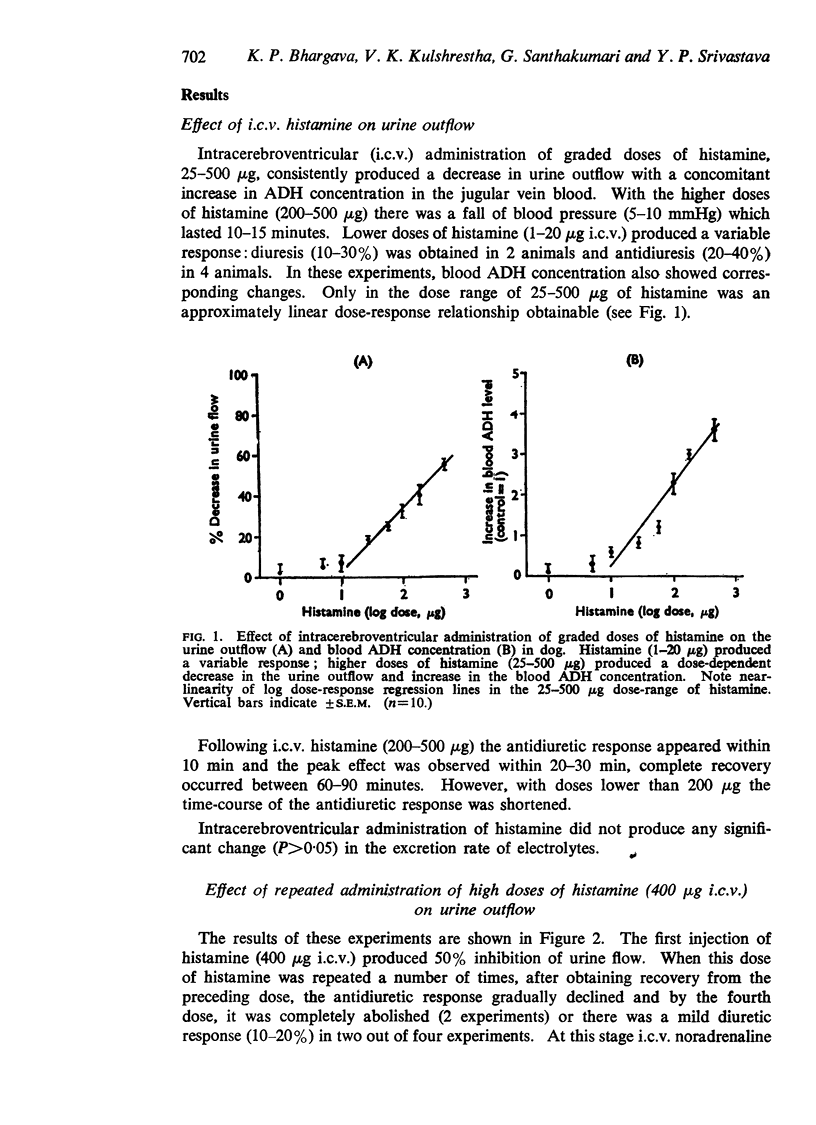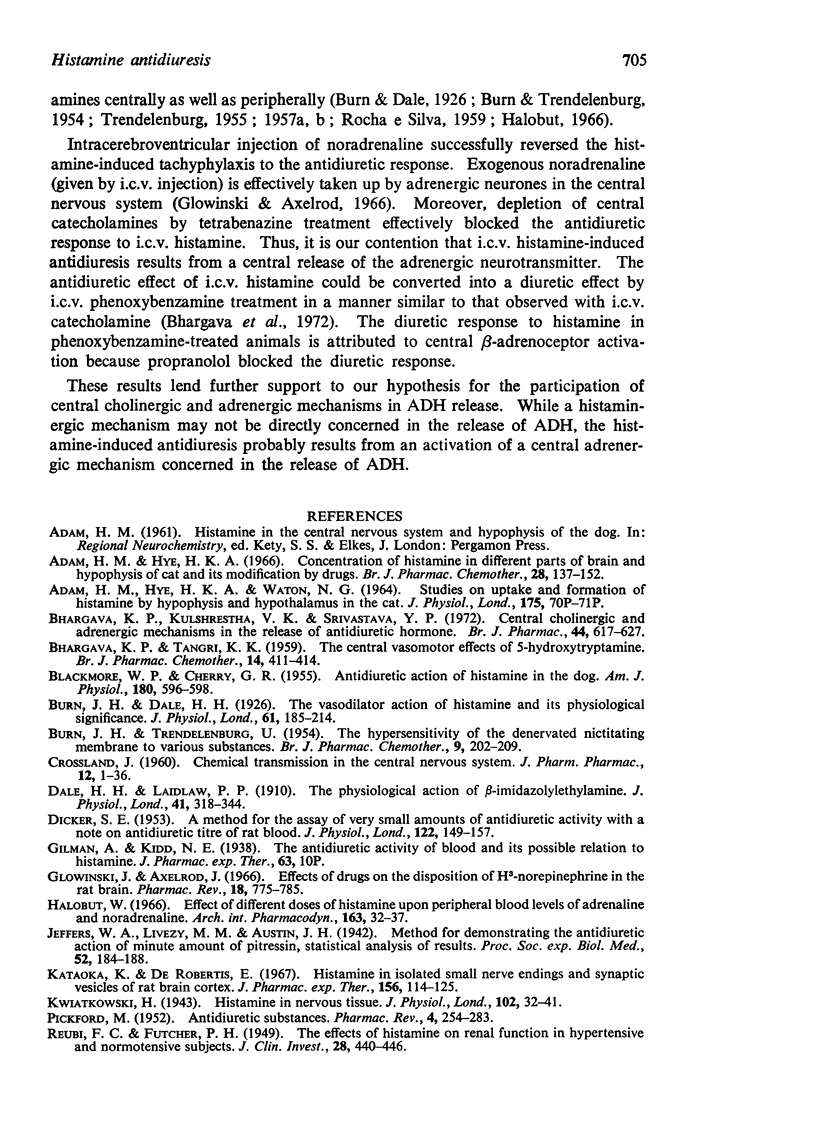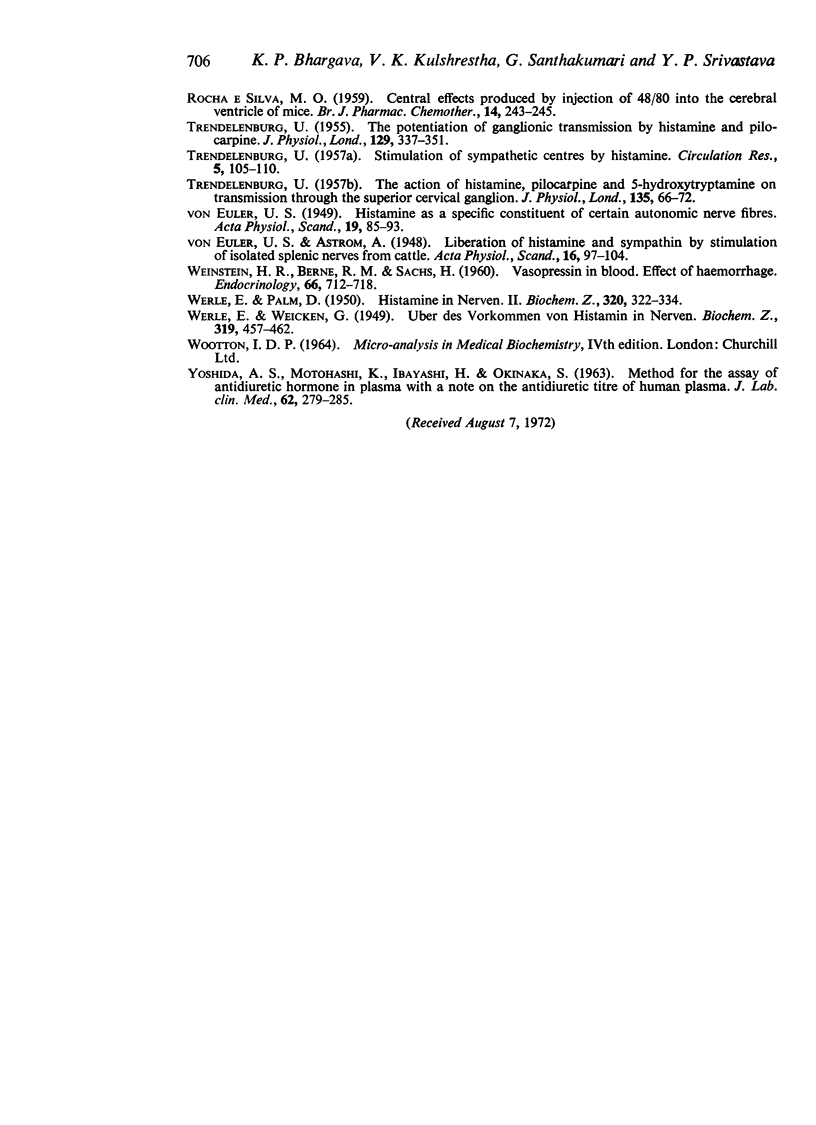Abstract
1. In dogs anaesthetized with α-chloralose, intracerebroventricular (i.c.v.) injection of histamine induced antidiuresis and increase in jugular vein blood antidiuretic hormone (ADH) level but no change in urinary electrolytes. The mechanism of the histamine-induced antidiuretic response was analysed by the use of pharmacological agents.
2. Histamine (i.c.v.) in 1-20 μg doses produced a variable effect on urine outflow as well as on the blood ADH concentration; however, higher doses (25-500 μg) of histamine elicited a dose-dependent antidiuretic response with concomitant rise in blood ADH titre.
3. Repeated administration of high doses of i.c.v. histamine (400 μg) elicited a diminishing antidiuretic response which was not observable after the fourth dose, thus exhibiting tachyphylaxis. The antidiuretic response to histamine could be restored by central administration of noradrenaline (500 μg).
4. Central pretreatment with mepyramine (5 mg) prevented the histamine-induced antidiuresis. Atropine (2 mg i.c.v.) was ineffective in blocking the antidiuretic effect of histamine. A diuretic response to histamine (400 μg i.c.v.) was obtained in phenoxybenzamine (i.c.v.) pretreated animals; this response could be blocked by i.c.v. injection of propranolol. Tetrabenazine pretreatment prevented the antidiuretic response to histamine.
5. The results of the study lead us to conclude that histamine releases central catecholamines which activate the central adrenergic mechanism for the release of antidiuretic hormone.
Full text
PDF






Selected References
These references are in PubMed. This may not be the complete list of references from this article.
- Adam H. M., Hye H. K. Concentration of histamine in different parts of brain and hypophysis of cat and its modification by drugs. Br J Pharmacol Chemother. 1966 Oct;28(1):137–152. doi: 10.1111/j.1476-5381.1966.tb01880.x. [DOI] [PMC free article] [PubMed] [Google Scholar]
- BHARGAVA K. P., TANGRI K. K. The central vasomotor effects of 5-hydroxytryptamie. Br J Pharmacol Chemother. 1959 Dec;14:411–414. doi: 10.1111/j.1476-5381.1959.tb00943.x. [DOI] [PMC free article] [PubMed] [Google Scholar]
- BLACKMORE W. P., CHERRY G. R. Antidiuretic action of histamine in the dog. Am J Physiol. 1955 Mar;180(3):596–598. doi: 10.1152/ajplegacy.1955.180.3.596. [DOI] [PubMed] [Google Scholar]
- BURN J. H., TRENDELENBURG U. The hypersensitivity of the denervated nictitating membrane to various substances. Br J Pharmacol Chemother. 1954 Jun;9(2):202–209. doi: 10.1111/j.1476-5381.1954.tb00842.x. [DOI] [PMC free article] [PubMed] [Google Scholar]
- Bhargava K. P., Kulshrestha V. K., Srivastava Y. P. Central cholinergic and adrenergic mechanisms in the release of antidiuretic hormone. Br J Pharmacol. 1972 Apr;44(4):617–627. doi: 10.1111/j.1476-5381.1972.tb07301.x. [DOI] [PMC free article] [PubMed] [Google Scholar]
- Burn J. H., Dale H. H. The vaso-dilator action of histamine, and its physiological significance. J Physiol. 1926 Apr 23;61(2):185–214. doi: 10.1113/jphysiol.1926.sp002283. [DOI] [PMC free article] [PubMed] [Google Scholar]
- CROSSLAND J. Chemical transmission in the central nervous system. J Pharm Pharmacol. 1960 Jan;12:1–36. doi: 10.1111/j.2042-7158.1960.tb12627.x. [DOI] [PubMed] [Google Scholar]
- DICKER S. E. A method for the assay of very small amounts of antidiuretic activity with a note on the antidiuretic titre of rat's blood. J Physiol. 1953 Oct;122(1):149–157. doi: 10.1113/jphysiol.1953.sp004986. [DOI] [PMC free article] [PubMed] [Google Scholar]
- Dale H. H., Laidlaw P. P. The physiological action of beta-iminazolylethylamine. J Physiol. 1910 Dec 31;41(5):318–344. doi: 10.1113/jphysiol.1910.sp001406. [DOI] [PMC free article] [PubMed] [Google Scholar]
- Glowinski J., Axelrod J. Effects of drugs on the disposition of H-3-norepinephrine in the rat brain. Pharmacol Rev. 1966 Mar;18(1):775–785. [PubMed] [Google Scholar]
- Kataoka K., De Robertis E. Histamine in isolated small nerve endings and synaptic vesicles of rat brain cortex. J Pharmacol Exp Ther. 1967 Apr;156(1):114–125. [PubMed] [Google Scholar]
- Kwiatkowski H. Histamine in nervous tissue. J Physiol. 1943 Jun 30;102(1):32–41. doi: 10.1113/jphysiol.1943.sp004011. [DOI] [PMC free article] [PubMed] [Google Scholar]
- PICKFORD M. Antidiuretic substances. Pharmacol Rev. 1952 Sep;4(3):254–283. [PubMed] [Google Scholar]
- ROCHA E., SILVA M. Central effects produced by injection of 48/80 into the cerebral ventricles of mice. Br J Pharmacol Chemother. 1959 Jun;14(2):243–245. doi: 10.1111/j.1476-5381.1959.tb01392.x. [DOI] [PMC free article] [PubMed] [Google Scholar]
- Reubi F. C., Futcher P. H. THE EFFECTS OF HISTAMINE ON RENAL FUNCTION IN HYPERTENSIVE AND NORMOTENSIVE SUBJECTS. J Clin Invest. 1949 May;28(3):440–446. doi: 10.1172/JCI102088. [DOI] [PMC free article] [PubMed] [Google Scholar]
- TRENDELENBURG U. Stimulation of sympathetic centers by histamine. Circ Res. 1957 Jan;5(1):105–110. doi: 10.1161/01.res.5.1.105. [DOI] [PubMed] [Google Scholar]
- TRENDELENBURG U. The action of histamine, pilocarpine and 5-hydroxytryptamine on transmission through the superior cervical ganglion. J Physiol. 1957 Jan 23;135(1):66–72. doi: 10.1113/jphysiol.1957.sp005695. [DOI] [PMC free article] [PubMed] [Google Scholar]
- TRENDELENBURG U. The potentiation of ganglionic transmission by histamine and pilocarpine. J Physiol. 1955 Aug 29;129(2):337–351. doi: 10.1113/jphysiol.1955.sp005358. [DOI] [PMC free article] [PubMed] [Google Scholar]
- WEINSTEIN H., BERNE R. M., SACHS H. Vasopressin in blood: effect of hemorrhage. Endocrinology. 1960 May;66:712–718. doi: 10.1210/endo-66-5-712. [DOI] [PubMed] [Google Scholar]
- WERLE E., PALM D. Histamin in Nerven. II. Biochem Z. 1950;320(3):322–334. [PubMed] [Google Scholar]
- YOSHIDA S., MOTOHASHI K., IBAYASHI H., OKINAKA S. METHOD FOR THE ASSAY OF ANTIDIURETIC HORMONE IN PLASMA WITH A NOTE ON THE ANTIDIURETIC TITER OF HUMAN PLASMA. J Lab Clin Med. 1963 Aug;62:279–285. [PubMed] [Google Scholar]


